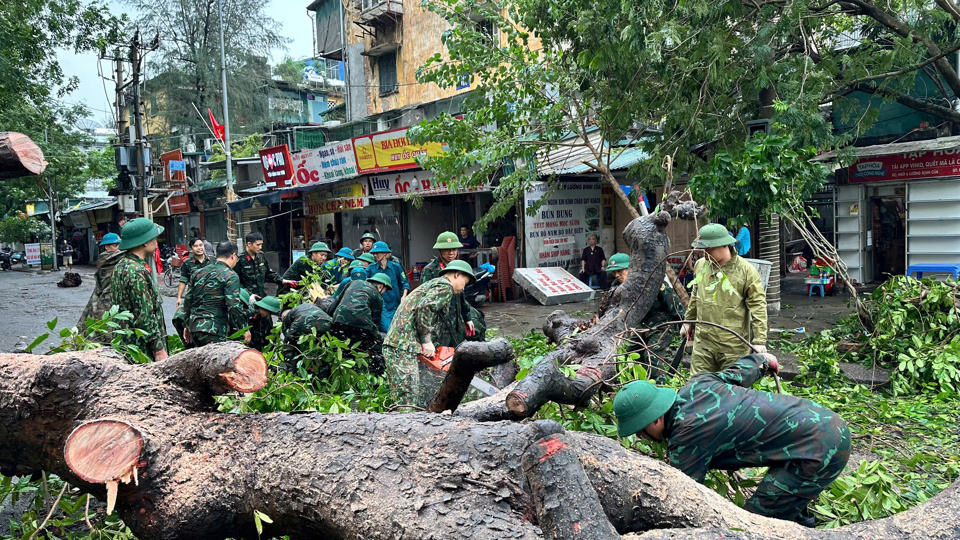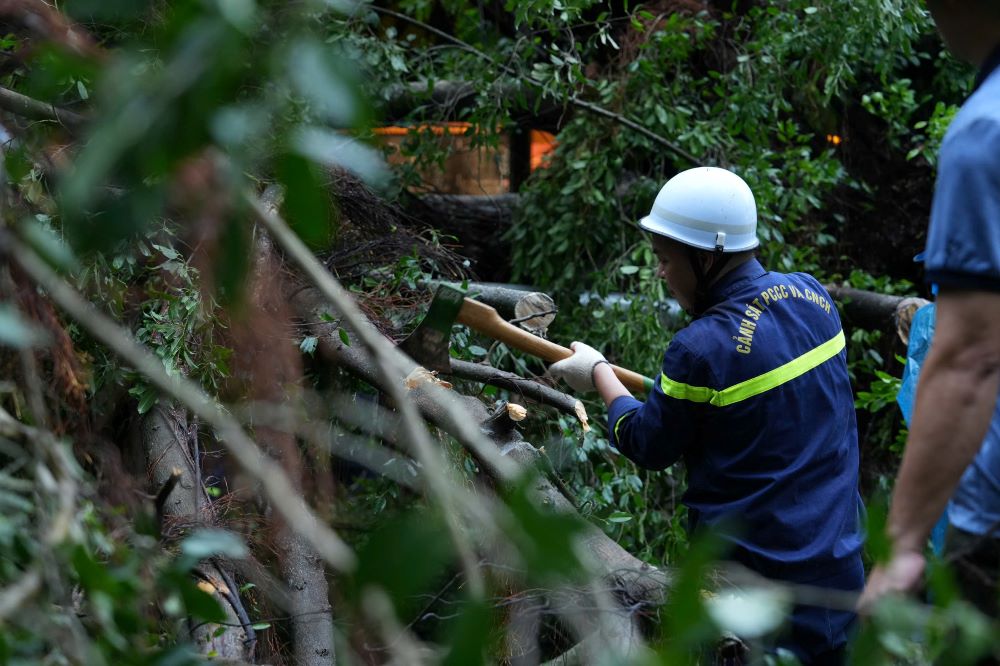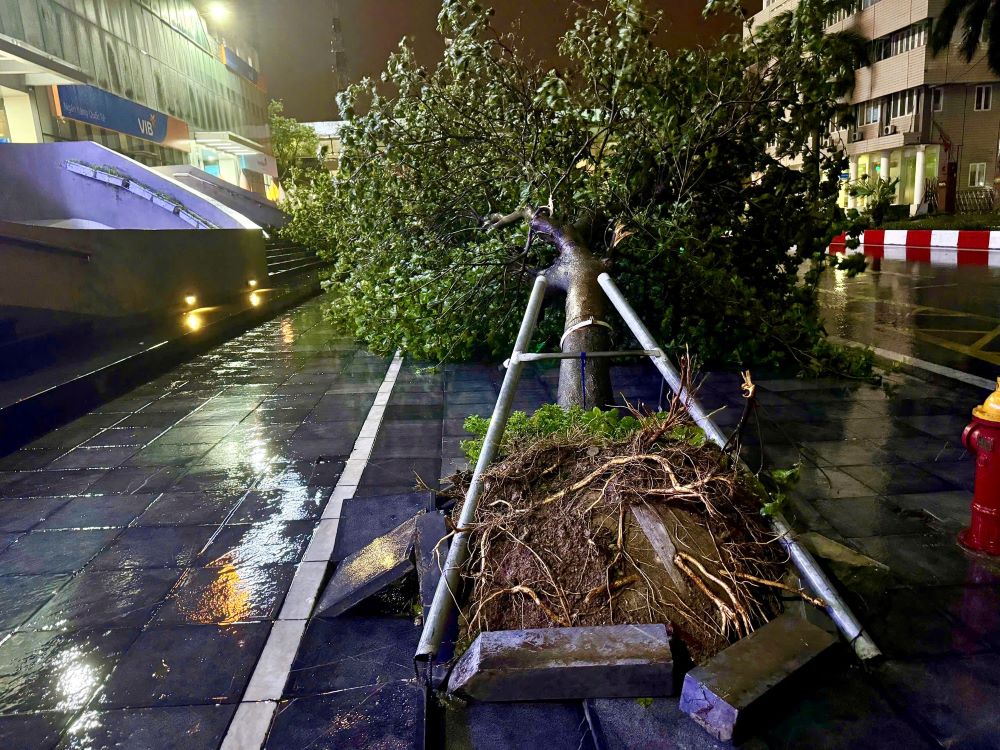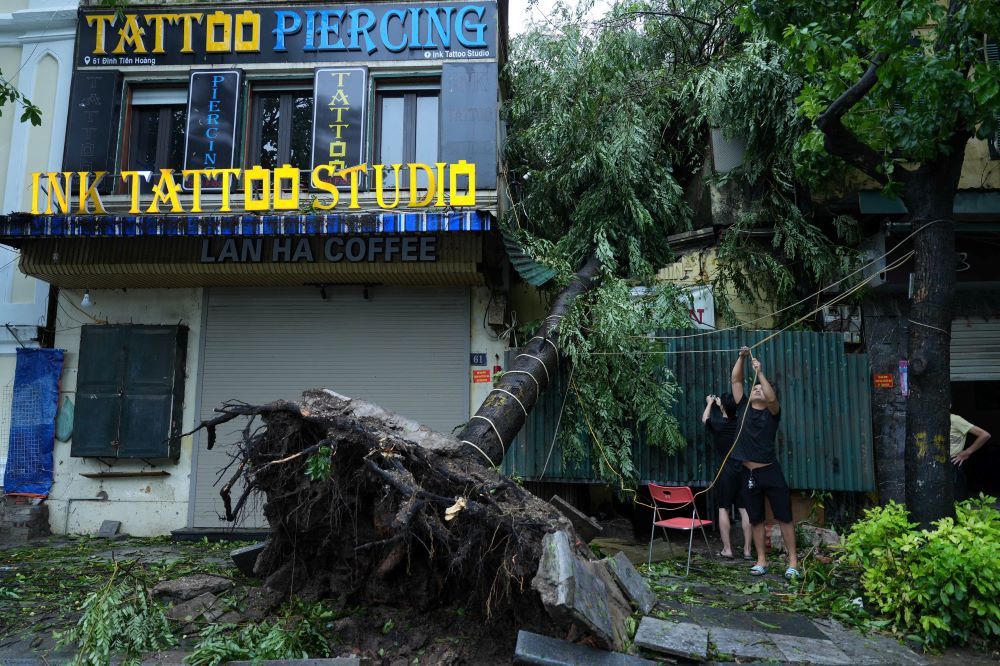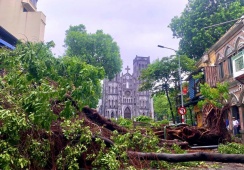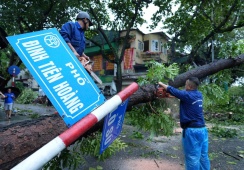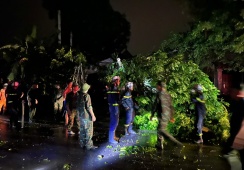
Chairman of the Hanoi People's Committee Chairman Tran Sy Thanh asked relevant agencies to quickly address fallen trees in the city after typhoon Yagi or Storm No. 3.
| Soldiers in Dong Da District, Hanoi help clear roads. |
In the document signed on September 8, he asked the Department of Construction, along with district and commune-level authorities, to coordinate efforts with tree management departments as per their jurisdiction.
All available resources, including personnel and equipment, will be mobilized to clear fallen trees and broken branches, prioritizing traffic safety on major roads, with a target completion date of September 12.
After this, ongoing work will focus on removing debris, replanting, replacing damaged trees, and cleaning up, following established guidelines.
For valuable or protected trees that have been uprooted or tilted, inspections will be conducted to determine if they can be replanted on-site or need to be transferred to nurseries for care. This task is set to be completed by September 15.
Urban trees with a diameter of less than 25 cm that have fallen or been damaged will be pruned and replanted on-site. Fallen trees on roads will be relocated to sidewalks or medians to ensure traffic safety until they can be replanted, with the work completed by September 20. The collection of wood and firewood from fallen trees will be finalized by the same date, following disposal procedures.
| Hanoi's Firefighting and Rescue Police handle falling trees after the storm. Photo: Duy Khanh/The Hanoi Times |
Thanh instructed district and town authorities to collaborate with the Department of Construction to identify suitable locations for replanting trees on sidewalks, ensuring proper quality, technical standards, and urban aesthetics. These locations must be agreed upon by September 30.
Meanwhile, the Department of Transport and the city’s police are responsible for managing traffic during tree clearing to ensure order and prevent congestion.
The Department of Natural Resources and Environment will direct the cleanup of branches and debris to maintain urban cleanliness and visual appeal.
The Department of Construction will lead the effort to develop a replanting plan for trees that cannot be salvaged, ensuring suitable species, sizes, and proper care techniques. Strong support structures must be used to safeguard trees from future storms while promoting their growth.
This department will also monitor and report progress to the local government by September 20 and promptly address any issues that arise during implementation.
| A tree uprooted on a Hanoi street during the storm. Photo: Duy Khanh/The Hanoi Times |
Shortcomings revealed
Concerning the issues related to urban trees, The Hanoi Times has talked with some local experts whose experiences help the long-term planning of green space and they have the same idea that there needs a revolution in urban tree management.
Due to the impact of the typhoon, thousands of trees in Hanoi were uprooted or damaged, causing economic losses, urban aesthetic issues, and revealing significant shortcomings in the city’s tree management and planting practices.
Statistics by the Hanoi Disaster Prevention and Search and Rescue Command showed that as of the evening of September 8, more than 25,000 trees had been uprooted or broken across the city, with 98% of them being completely uprooted, especially in the districts of Hoang Mai, Long Bien, Gia Lam, Dong Anh, and Nam Tu Liem. The fallen trees sometimes caused injuries and damaged vehicles and infrastructure.
However, the incidents reveal issues in the current tree management system. Many of the fallen trees appeared not to have been planted according to proper techniques. Some trees still had plastic wrappings around their roots, and others were planted too shallowly, increasing the risk of toppling during storms.
| A tree uprooted in Dinh Tien Hoang Street, Hanoi as typhoon Yagi swept away. Photo: Duy Khanh/The Hanoi Times |
An expert from Hanoi’s neighboring province of Hung Yen explained that during urban tree planting, plastic or mesh wrappings are often used to secure the soil around the tree roots during transport. However, it is crucial to remove these wrappings before planting, particularly if made of plastic, to allow the roots to absorb water and grow deep into the soil. Additionally, planting holes should be two to three times the size of the tree’s root ball to ensure healthy growth.
In this regard, Nguyen Duc Hung, Director of the Technical Infrastructure Management Center in Hanoi, emphasized the need for policies that ensure the effective implementation of urban tree planning, development, and maintenance. A complete regulatory framework is necessary for managing and maintaining urban infrastructure, particularly trees, post-investment.
Relevant authorities should assign clear responsibilities to local governments, police, and organizations for protecting and developing urban greenery. Strict penalties should be enforced against individuals and entities that fail to comply with tree management regulations.
Echoing this view, Associate Professor Dr. Luu Duc Hai, Director of the Vietnam Institute for Urban Research and Infrastructure Development, highlighted the importance of urban trees in enhancing city life, providing aesthetic, economic, and environmental benefits.
To achieve sustainable urban tree development, “Vietnam must quickly refine and update management processes and regulations to suit the growth characteristics of trees. This approach will support the sustainable development of urban greenery in Hanoi and across the country,” Hai stressed.
